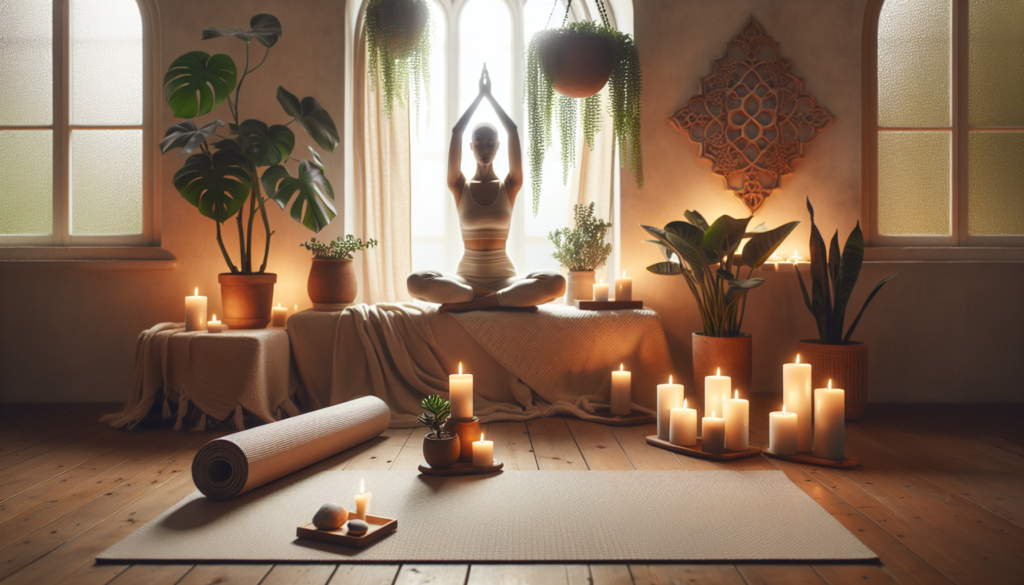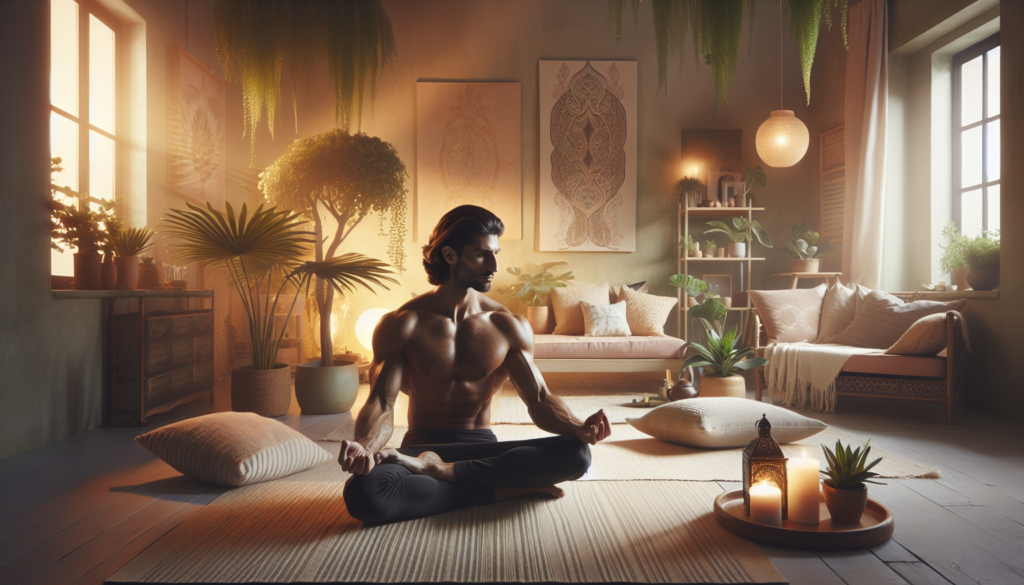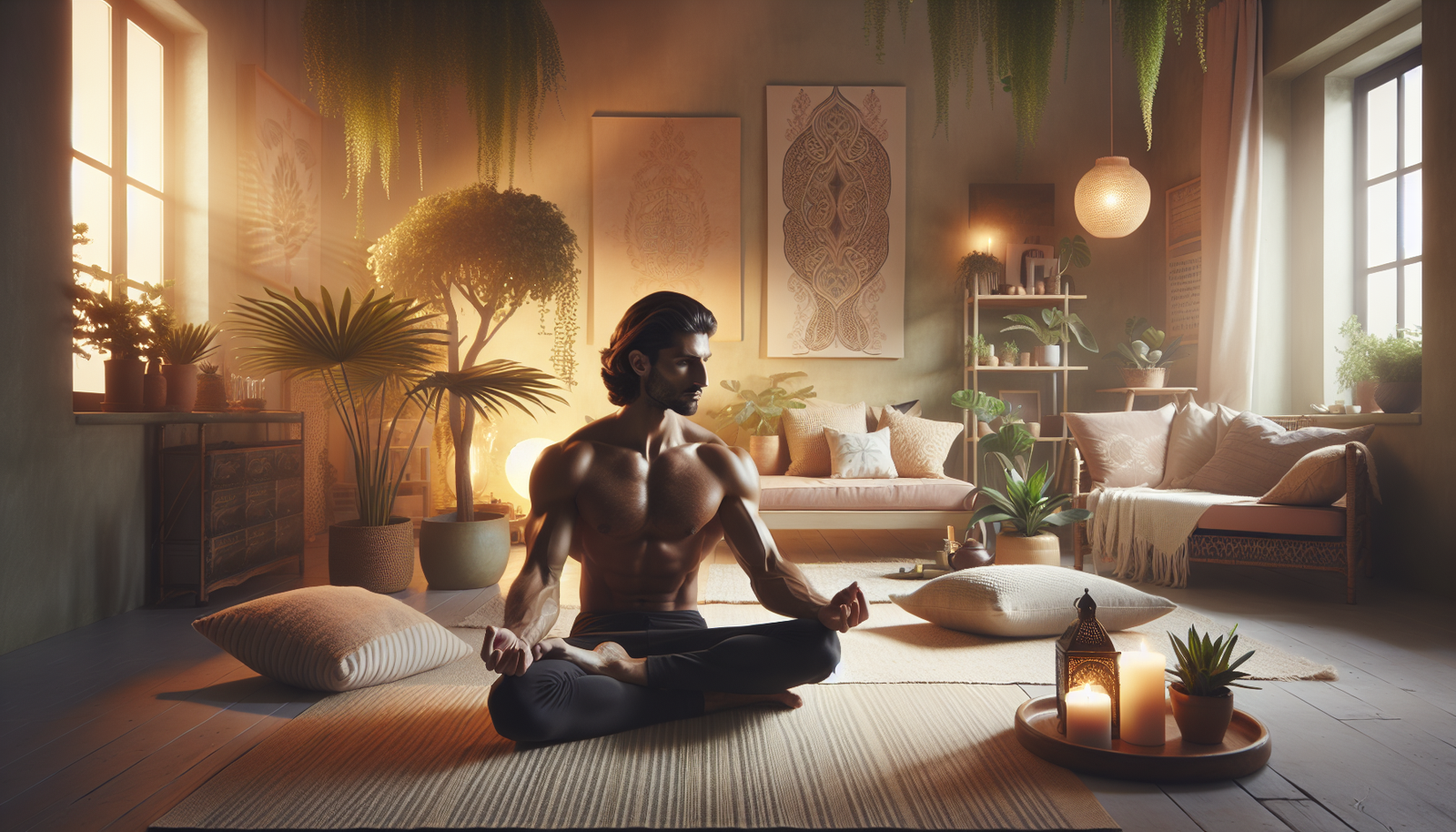Are you looking to elevate your home yoga practice to a whole new level of tranquility and mindfulness? If so, you may have found yourself wondering how you can seamlessly integrate meditation into your routine. The beautiful thing is that you don’t need any fancy equipment or a dedicated meditation space to make this happen. By incorporating simple yet effective techniques, you can effortlessly infuse moments of meditation into your home yoga sessions, creating a harmonious balance between the mind, body, and soul.

Setting up a Sacred Space for Meditation
Choosing a quiet and comfortable location
When it comes to creating a sacred space for meditation, the first step is to find a quiet and comfortable location in your home. Look for a room or corner where you can have some privacy and won’t be easily disturbed. This could be a spare bedroom, a cozy nook in your living room, or even a tranquil spot in your backyard. The key here is to choose a space where you feel safe and at ease, allowing you to fully immerse yourself in the practice of meditation.
Clearing clutter and creating a serene ambiance
Once you’ve chosen the location for your meditation space, it’s essential to clear away any clutter or distractions that may hinder your ability to focus. Remove unnecessary furniture, decorations, and personal belongings from the area to create a clean and open space. Consider using natural elements such as plants, candles, or a small waterfall feature to create a serene ambiance. Soft lighting and soothing colors can also contribute to a calm and peaceful atmosphere for your meditation practice.
Adding meaningful decorations and symbols
To further enhance the sacredness of your meditation space, consider adding meaningful decorations and symbols that resonate with you. This could be a Buddha statue, a picture of a serene landscape, or symbols that represent spiritual concepts important to you. These decorations and symbols serve as reminders of your intention to cultivate inner peace and provide a visual focus during your meditation practice. Choose items that personally inspire and uplift you, creating a space that reflects your individual spiritual journey.
Creating a Daily Meditation Routine
Finding a suitable time for meditation
Establishing a daily meditation routine requires finding a suitable time that works best for you and your schedule. Some people prefer to meditate first thing in the morning to start their day with a clear and focused mindset. Others find that meditating in the evening helps them unwind and release the stresses of the day. Experiment with different times of the day to see what aligns with your energy levels and allows you to fully commit to the practice.
Setting a realistic duration for meditation
As you begin incorporating meditation into your daily routine, it’s important to set a realistic duration for your practice. Start with shorter sessions, such as 5-10 minutes, and gradually increase the length as you become more comfortable and confident in your meditation abilities. Remember, the key is consistency, so even a short meditation session can have positive effects on your mental and emotional well-being.
Experimenting with different meditation techniques
There are countless meditation techniques available, and it’s worth exploring different approaches to find the ones that resonate with you. Some popular techniques include mindfulness meditation, loving-kindness meditation, and transcendental meditation. Each technique offers unique benefits and focuses on different aspects of the mind and body. Don’t be afraid to experiment and see which techniques bring you the most tranquility and inner peace.
Combining Yoga Asanas with Meditation
Starting with a gentle warm-up
Before diving into meditation, it can be beneficial to start with a gentle warm-up to prepare your body and mind for stillness. Incorporate a short yoga sequence to help release physical tension and create a sense of openness and relaxation. This can include gentle stretches, sun salutations, and breathing exercises. By warming up your body, you’ll find it easier to settle into a comfortable seated position for meditation.
Incorporating seated meditation postures
Finding the right seated posture is crucial for a comfortable and effective meditation practice. Choose a posture that allows you to sit with a straight spine while keeping your body relaxed and at ease. Popular seated postures include cross-legged, lotus, or kneeling with the support of cushions or a meditation bench. Experiment with different postures to find the one that suits you best and allows for a focused and stable meditation session.
Transitioning from asanas to meditation
Once you’ve completed your warm-up and settled into a seated posture, it’s time to transition from yoga asanas to meditation. Take a few moments to center yourself and bring your attention to the present moment. Begin by focusing on your breath, observing each inhalation and exhalation. Allow any physical sensations, thoughts, or emotions to arise without judgment, gently redirecting your focus back to the breath. In this way, you can seamlessly transition from the physical practice of yoga to the more inward-focused practice of meditation.
Using Breath Control and Mantras
Exploring breath-focused meditation techniques
Breath-focused meditation techniques center around observing and controlling the breath to cultivate a state of calm and relaxation. One popular technique is deep abdominal breathing, also known as diaphragmatic breathing. Sit in a comfortable position and place your hands on your abdomen. Inhale deeply, allowing your abdomen to expand, and exhale slowly, feeling your abdomen contract. This technique helps slow down the breath and promotes a sense of tranquility and centeredness.
Incorporating mantras or affirmations
Mantras or affirmations can be a powerful tool to enhance your meditation practice. A mantra is a word, phrase, or sound that is repeated silently or aloud to aid concentration and focus. Choose a mantra that resonates with you, such as “peace,” “love,” or “I am calm and centered.” Repeat your chosen mantra throughout your meditation session, allowing it to become a focal point and help quiet the mind.
Using pranayama techniques to deepen meditation
Pranayama, or the control of breath, is an integral part of yoga and can also be utilized to deepen your meditation practice. Incorporate pranayama techniques such as alternate nostril breathing, where you block one nostril while inhaling and exhaling through the other. This technique balances the energy in the body and brings a sense of harmony and clarity to the mind. Experiment with different pranayama techniques and observe how they enhance your meditation experience.

Guided Meditation via Online Resources
Exploring guided meditation apps
If you are new to meditation or find it difficult to maintain focus on your own, guided meditation apps can be a valuable resource. These apps provide pre-recorded meditation sessions led by experienced instructors, guiding you through each step of the practice. Popular apps include Headspace, Calm, and Insight Timer. Explore different apps to find the one that resonates with you and offers the style of meditation that aligns with your goals and preferences.
Joining online meditation communities
In today’s digital age, there are numerous online meditation communities where you can connect with like-minded individuals and receive support in your practice. Joining these communities allows you to share your experiences, ask questions, and learn from others who are on a similar path. Online forums, social media groups, or even virtual meditation classes can provide a sense of community and accountability, enhancing the overall meditation experience.
Finding reputable guided meditation websites or videos
In addition to apps and online communities, there are reputable websites and videos that offer guided meditation sessions. These resources often provide a variety of meditation styles and lengths, allowing you to choose what suits your current needs. Websites like YouTube or Insight Timer offer a vast library of meditation videos from experienced teachers. Take advantage of these resources to explore different guided meditations and find the ones that resonate with you.
Maintaining Consistency and Accountability
Setting a meditation schedule and sticking to it
Consistency is key when it comes to establishing a meditation practice. Set a regular meditation schedule and commit to it, just as you would with any other important appointment in your life. Whether it’s early in the morning, during your lunch break, or before bedtime, prioritize your meditation practice and make it a non-negotiable part of your daily routine. By creating a schedule and sticking to it, you will cultivate discipline and ensure that meditation becomes an integral part of your life.
Finding a meditation buddy or group
Having a meditation buddy or joining a meditation group can provide additional support and accountability. Find a friend or family member who is also interested in meditation and commit to practicing together. You can share your experiences, discuss different techniques, or simply meditate side by side. Alternatively, consider joining a local meditation group or class where you can connect with others who share your passion for mindfulness. This sense of community can help you stay motivated and inspired on your meditation journey.
Tracking progress and celebrating milestones
It can be helpful to track your progress and celebrate milestones throughout your meditation practice. Keep a meditation journal where you record the duration of each session, any insights or experiences, and any challenges you encountered. This journal serves as a reminder of your dedication and progress over time. Additionally, set small goals for yourself, such as increasing the duration of your sessions or incorporating a new technique, and celebrate each milestone as you reach it. By acknowledging and celebrating your progress, you will stay motivated and inspired to continue deepening your meditation practice.
Adapting Meditation Techniques to Your Practice
Choosing meditation techniques that align with yoga practice goals
When integrating meditation into your home yoga practice, it’s essential to choose techniques that align with your specific goals. If your yoga practice focuses on physical strength and flexibility, you may choose to incorporate meditation techniques that promote relaxation and stress reduction. On the other hand, if your yoga practice centers around mindfulness and awareness, mindfulness meditation techniques may be a natural fit. Aligning your meditation techniques with your overall yoga practice goals will create a harmonious and well-rounded experience.
Modifying meditation techniques for different yoga styles
There are various styles of yoga, each with its own unique characteristics and goals. As you integrate meditation into your home yoga practice, it’s important to modify meditation techniques to suit the style of yoga you are practicing. For example, if you are practicing a vigorous vinyasa flow, you may choose to incorporate shorter and more energizing meditation sessions. On the other hand, if you are practicing yin or restorative yoga, longer and more introspective meditation sessions may be more appropriate. By adapting your meditation techniques to different yoga styles, you can maximize the benefits of both practices.
Experimenting with different meditation techniques for diverse benefits
As you continue to evolve in your home yoga practice, don’t be afraid to experiment with different meditation techniques to experience diverse benefits. Some techniques may be more suitable for stress reduction and relaxation, while others may enhance focus and concentration. Explore techniques such as walking meditation, body scan meditation, or visualization meditation to discover new dimensions of your practice. By embracing variety and experimentation, you’ll gain a deeper understanding of yourself and the transformative power of meditation.
Incorporating Meditation into Yoga Sequences
Beginning or ending a yoga sequence with meditation
One effective way to integrate meditation into your home yoga practice is to either begin or end your yoga sequence with meditation. Starting your practice with meditation helps you transition from your daily activities into a focused and centered state of mind. It prepares your body and mind for the physical practice of yoga, allowing you to be fully present on the mat. Ending your practice with meditation allows you to integrate the benefits of your physical practice and brings a sense of calm and grounding before moving into the rest of your day. Experiment with different approaches to find what works best for you.
Integrating moments of meditation throughout the practice
In addition to beginning or ending a yoga sequence with meditation, you can also integrate moments of meditation throughout your practice. This can include taking short breaks between yoga poses to focus on your breath and bring awareness to the present moment. For example, after a challenging pose, take a few moments to close your eyes, take a deep breath, and observe the sensations in your body. These mini-meditation moments help you stay connected to your breath, maintain mindfulness, and deepen your overall yoga practice.
Designing a dedicated yoga sequence for meditation
For those who wish to fully immerse themselves in a meditation-focused practice, designing a dedicated yoga sequence for meditation can be a transformative experience. This sequence can be tailored specifically to prepare your body and mind for an extended meditation session. Include gentle warm-up poses, stretches, and breathing exercises to release physical tension and create a sense of relaxation. As you move through the sequence, gradually transition into longer and deeper meditation sessions. Designing your own dedicated yoga sequence for meditation allows you to set the intention and create an environment that is conducive to a profound and transformative meditation experience.
Using Props and Accessories for Meditation
Exploring different types of meditation cushions
When it comes to sitting comfortably during meditation, using a cushion can make a significant difference. Meditation cushions, also known as zafus or zabutons, provide support, stability, and help maintain a proper posture. There are various types of cushions available, including round or crescent-shaped cushions filled with buckwheat hulls or kapok. Explore different options and choose a cushion that suits your body shape and supports your meditation practice.
Utilizing meditation benches or stools
If sitting on the floor is uncomfortable for you, consider utilizing a meditation bench or stool. These accessories provide an alternative seating option and can be especially helpful for individuals with knee or back issues. Meditation benches or stools allow you to sit at a slightly elevated angle, promoting an upright posture while keeping your spine aligned. Experiment with different types of benches or stools to find the one that provides the most comfort and stability for your meditation practice.
Incorporating blankets, eye pillows, or essential oils
To create a more cozy and soothing meditation experience, you can incorporate additional props and accessories. Blankets can be used for extra cushioning or to keep yourself warm during longer meditation sessions. Eye pillows or masks can be placed over your eyes to block out light and enhance relaxation. You can also introduce essential oils such as lavender or frankincense to promote a calm and peaceful ambiance. These props and accessories add an extra layer of comfort and sensory experience to your meditation practice, creating a sacred space that supports deep relaxation and tranquility.
Seeking Guidance from Meditation Teachers
Attending meditation workshops or retreats
For those seeking deeper guidance and connection in their meditation practice, attending meditation workshops or retreats can be a profound experience. These immersive experiences provide an opportunity to learn from experienced meditation teachers, immerse yourself in a supportive community, and deepen your meditation practice. Whether it’s a weekend retreat or a longer intensive program, these events offer a dedicated space and time to dive deeper into your meditation journey and gain valuable insights and techniques.
Finding a meditation teacher or mentor
If you prefer a more personalized approach, finding a meditation teacher or mentor can provide invaluable guidance and support. A meditation teacher can help you refine your meditation technique, offer insights into your practice, and provide accountability and encouragement. Look for experienced teachers in your local community or consider seeking guidance from renowned meditation teachers through virtual sessions. Remember, finding the right teacher or mentor is essential, so take the time to explore different options and choose someone who resonates with your values and approach to meditation.
Scheduling private meditation sessions
Private meditation sessions offer a unique opportunity to receive personalized guidance and support tailored to your specific needs and goals. During these sessions, you can work one-on-one with a meditation teacher to address any challenges or obstacles you may encounter in your practice. A meditation teacher can offer individualized techniques, mindfulness exercises, and assist you in deepening your meditation experience. If you prefer a more structured and personalized approach to your meditation practice, scheduling private sessions can be highly beneficial in your growth and development as a meditator.
In conclusion, integrating meditation into your home yoga practice can bring numerous benefits to your physical, mental, and spiritual well-being. By setting up a sacred space, creating a daily meditation routine, combining yoga asanas with meditation, using breath control and mantras, exploring guided meditation resources, maintaining consistency and accountability, adapting meditation techniques to your practice, incorporating meditation into yoga sequences, utilizing props and accessories, and seeking guidance from meditation teachers, you can cultivate a deeper connection to yourself and unlock the transformative power of meditation. Embrace the journey and allow meditation to become an integral part of your home yoga practice.

